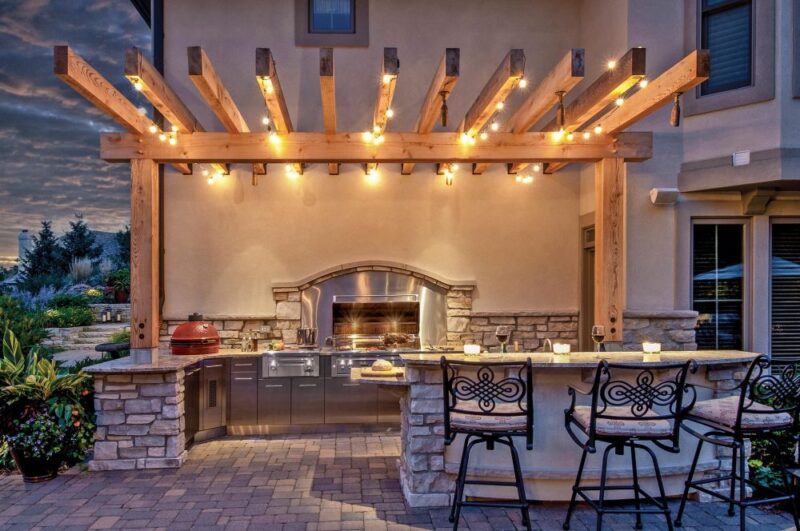Outdoor kitchens have surged in popularity as more homeowners seek to expand their living spaces outside.
Style, comfort, and functionality play equal roles in creating a place where food preparation and socializing flow seamlessly.
Practical decoration ideas can transform any outdoor setup into a comfortable, inviting, and personalized cooking and dining space suitable for all budgets.
1. Choose a Cohesive Design Theme
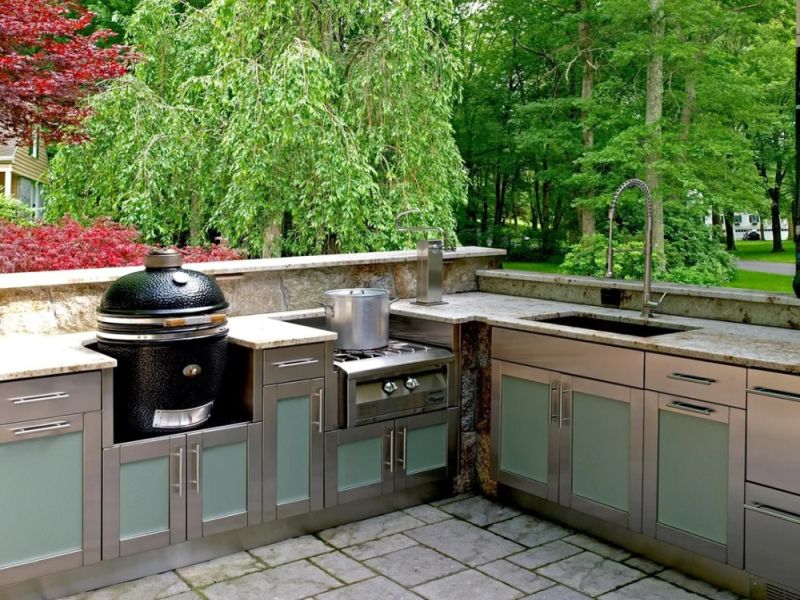
Without a guiding theme, the space can feel disjointed, with mismatched materials and styles competing for attention.
A theme sets the tone for the entire cooking and dining experience, allowing the kitchen to reflect personal style while blending with the surrounding home and outdoor setting.
Different themes bring their own advantages, creating distinct atmospheres:
- Rustic: Emphasizes warmth through natural wood beams, stone walls, and textured finishes.
- Mediterranean: Showcases terracotta tiles, stucco finishes, arches, and earthy tones.
- Modern Minimalist: Focuses on clean lines, sleek surfaces, and a restrained color palette.
- Industrial: Incorporates exposed metal, dark tones, and polished concrete.
- Farmhouse: Highlights painted wood cabinetry, white finishes, and natural accents.
- Tropical: Features bamboo, palm-inspired textures, and vibrant colors.
Materials and finishes reinforce the chosen theme while adding durability.
Stone, wood, stainless steel, and ceramic tiles should be selected carefully to maintain visual consistency.
For example, a farmhouse layout benefits from painted cabinetry and wood countertops, while a Mediterranean style thrives with patterned tiles and warm stone.
The connection between the kitchen and home architecture is equally important.
Matching rooflines, flooring transitions, and color palettes ensures the outdoor kitchen feels like a natural extension of the property rather than an afterthought.
Garden design can also support the theme; for instance, lush greenery enhances a tropical style, while orderly hedges complement a modern minimalist approach.
2. Prioritize Durable, Weather-Resistant Materials
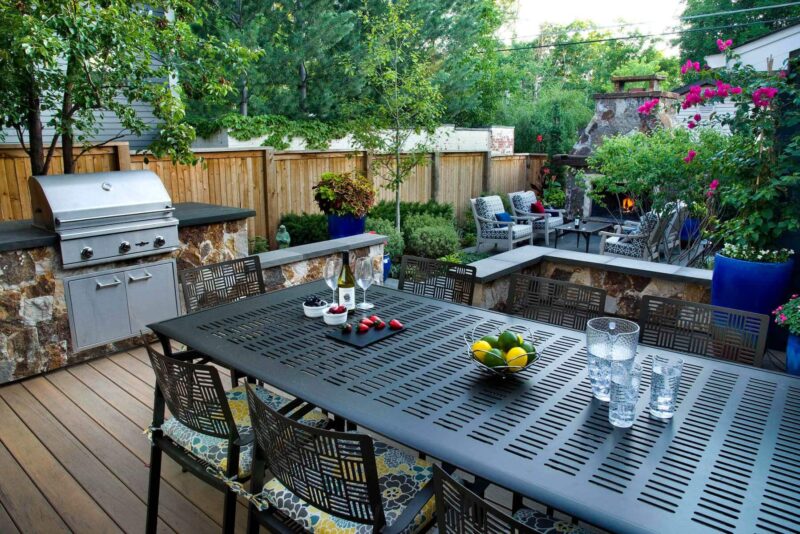
Exposure to rain, direct sun, wind, and fluctuating temperatures can quickly damage unprotected finishes, so every choice should balance style with resilience.
Popular materials that perform well in outdoor settings include:
- Stainless Steel: Resistant to rust, simple to clean, and suitable for cabinets, appliances, and even countertops.
- Concrete: Delivers both strength and a modern aesthetic while withstanding constant exposure.
- Natural Stone: Provides long-lasting beauty, available in options like granite, slate, or travertine.
- Treated or Composite Wood: Adds warmth without the risk of rot or decay often associated with untreated timber.
Exterior-rated finishes for cabinets, countertops, and hardware help shield surfaces against fading, warping, or cracking.
Drawer handles and hinges should be rust-proof, while cabinetry should be treated with sealants to withstand moisture.
Flooring materials should also be chosen carefully, with non-slip surfaces adding both safety and practicality.
Investing in resilient materials upfront avoids frequent repairs and replacements.
Kitchens built with poor-quality finishes often suffer peeling paint, warped wood, and rusty hardware, diminishing both function and appearance.
Selecting materials designed for outdoor conditions ensures the kitchen remains stylish, easy to maintain, and reliable throughout the seasons.
3. Add Warmth and Atmosphere
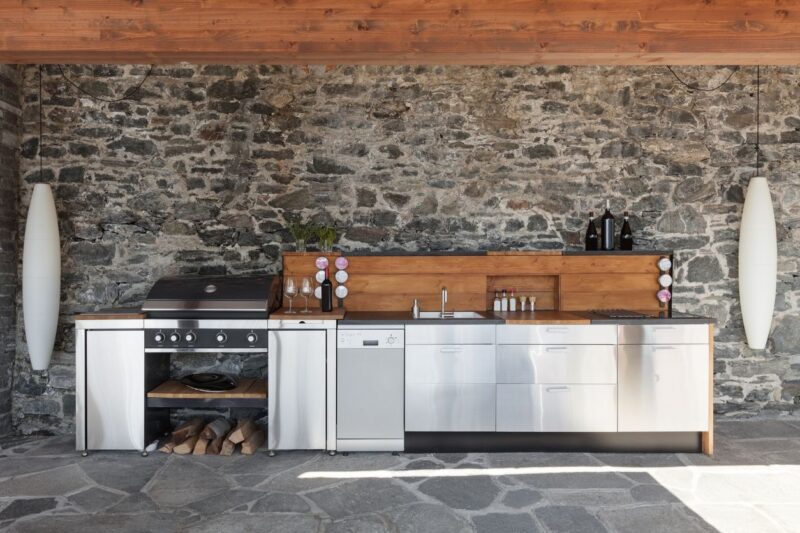
A welcoming outdoor kitchen thrives on atmosphere, and fire elements contribute both comfort and visual drama.
Adding warmth extends usability well into cooler months, transforming a cooking space into an inviting gathering area after dark.
Warmth fosters a relaxed environment, encouraging longer meals and social interactions. Fire features also provide illumination, pairing beautifully with layered lighting to create a cozy glow.
Regions with colder climates benefit especially from heat features. Without them, outdoor kitchens often go unused in the winter months.
Lake and pond equipment can enhance these setups further, complementing fire features with practical additions that balance ambiance and function in larger yards.
4. Integrate Comfortable and Functional Seating
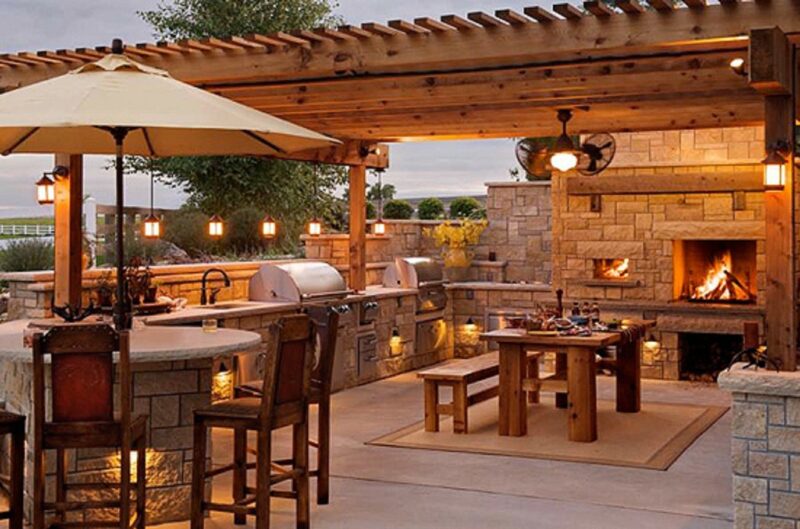
Seating is central to transforming an outdoor kitchen into a social hub.
Guests want to relax, chat, and dine in comfort, and the right arrangement supports both casual snacking and full sit-down meals.
Thoughtful seating ensures the kitchen is not just a place for cooking but also a destination for connection.
Options for functional seating include:
- Bar Stools: Ideal for counters or islands, allowing guests to interact with the cook.
- Banquettes: Provide cozy nooks with built-in cushions, perfect for families or small gatherings.
- Dining Sets: Large tables and chairs accommodate full meals under open skies.
Outdoor-rated cushions and upholstery enhance comfort while resisting water, fading, and mildew.
Certain materials ensure seating retains both style and durability over time.
Functional layout is equally important. A clear division between cooking and seating areas prevents overcrowding while still encouraging interaction.
Hospitality shines through seating choices. Providing a mix of casual and formal arrangements allows guests to choose where they feel most comfortable.
A thoughtfully designed seating area transforms an outdoor kitchen into more than a place to cook; it becomes an extension of warmth and welcome.
5. Layer Lighting for Ambiance and Safety
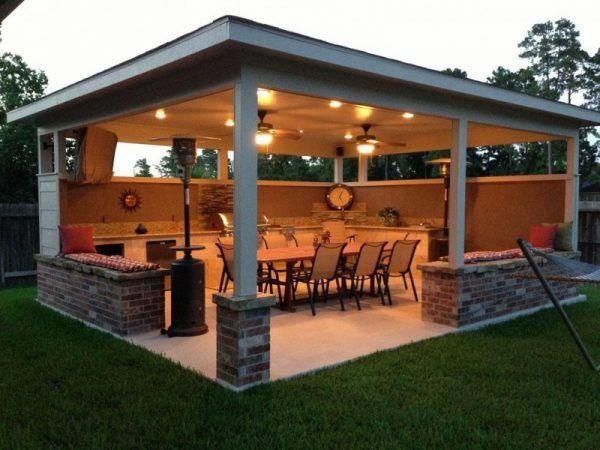
Daylight fades, but gatherings often continue into the evening, making proper illumination essential for both safety and style.
A layered approach combines different lighting types to achieve balance:
Solar-powered and low-voltage options save energy while reducing environmental impact.
Pathway lighting guides guests while preventing accidents, while softer glows around dining areas create intimacy.
Adjustable lighting systems allow you to switch between brighter task lights and dimmer tones for relaxed meals.
Layered lighting also highlights design elements such as decorative backsplashes or fire features.
A thoughtful arrangement of lights ensures the kitchen serves both practical needs and atmospheric goals, transforming it into an inviting retreat no matter the hour.
6. Add Natural Elements with Greenery and Landscaping
Plants play a transformative role in outdoor kitchens, softening hard surfaces and connecting built spaces to the surrounding garden.
Ideas for integrating natural elements include:
- Planters with Herbs: Basil, rosemary, and mint can be harvested directly for cooking.
- Vertical Gardens: Living walls save space while adding color and texture.
- Flower Beds and Shrubs: Provide natural barriers that enhance privacy and define zones.
Landscaping can separate dining areas from cooking spaces, creating distinct zones without heavy walls or fences.
Trees or tall plants can serve as natural windbreaks while also providing shade.
Seasonal blooms offer variety, while evergreens ensure greenery year-round.
Plants bring sensory benefits, too. Fragrance, color, and the soothing presence of greenery enhance relaxation.
7. Include Shelter for All-Weather Use

Weather remains one of the biggest challenges for outdoor kitchens, and proper shelter ensures usability in any condition.
Shade, protection, and coverage transform a seasonal cooking area into a year-round retreat.
Shelters shield appliances, furniture, and guests from harsh sun, unexpected rain, or even snow.
They also preserve the longevity of:
- Cabinets
- Countertops
- Electronics
A pergola paired with string lights creates ambiance, while a retractable awning allows more control depending on the time of day.
Guests feel more comfortable when conditions are managed, ensuring that gatherings continue regardless of the weather.
Shelter frames the outdoor kitchen, adding architectural interest while offering peace of mind for homeowners who want to use the space year-round.
8. Use Decorative Backsplashes and Surfaces
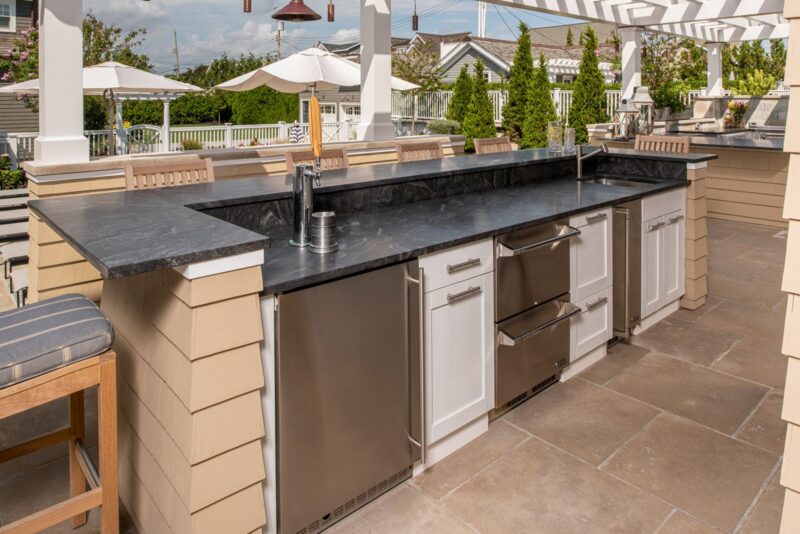
Backsplashes and surfaces add personality to outdoor kitchens while serving functional purposes.
A backsplash not only protects walls but also creates a focal point that defines style.
Common materials for backsplashes include:
- Stone: Rustic, timeless, and durable.
- Tile: Colorful, patterned, or neutral, depending on the theme.
- Brick: Warm, textural, and classic.
Surfaces such as countertops must balance style and resilience.
Granite, quartz, and polished concrete resist weather while offering polished aesthetics.
Color choices and textures should align with cabinetry and flooring, ensuring cohesion across the design.
Decorative elements prevent the space from feeling plain. A striking tile backsplash can introduce color, while a neutral stone counter keeps the overall effect balanced.
Surfaces enhance both practicality and creativity, giving the outdoor kitchen a polished finish that elevates the entire space.
9. Maximize Storage Without Sacrificing Style
Storage is often overlooked in outdoor kitchens, yet it plays a vital role in keeping the space organized and functional.
Clutter-free counters enhance both appearance and usability.
Stylish solutions can align with the overall theme.
Stainless steel drawers pair well with modern designs, while wood cabinetry suits rustic or farmhouse settings.
Upcycled furniture introduces character and sustainability.
Well-designed storage reduces unnecessary trips indoors, ensuring that everything needed for cooking or entertaining remains nearby.
10. Personalize with Decor and Color Accents
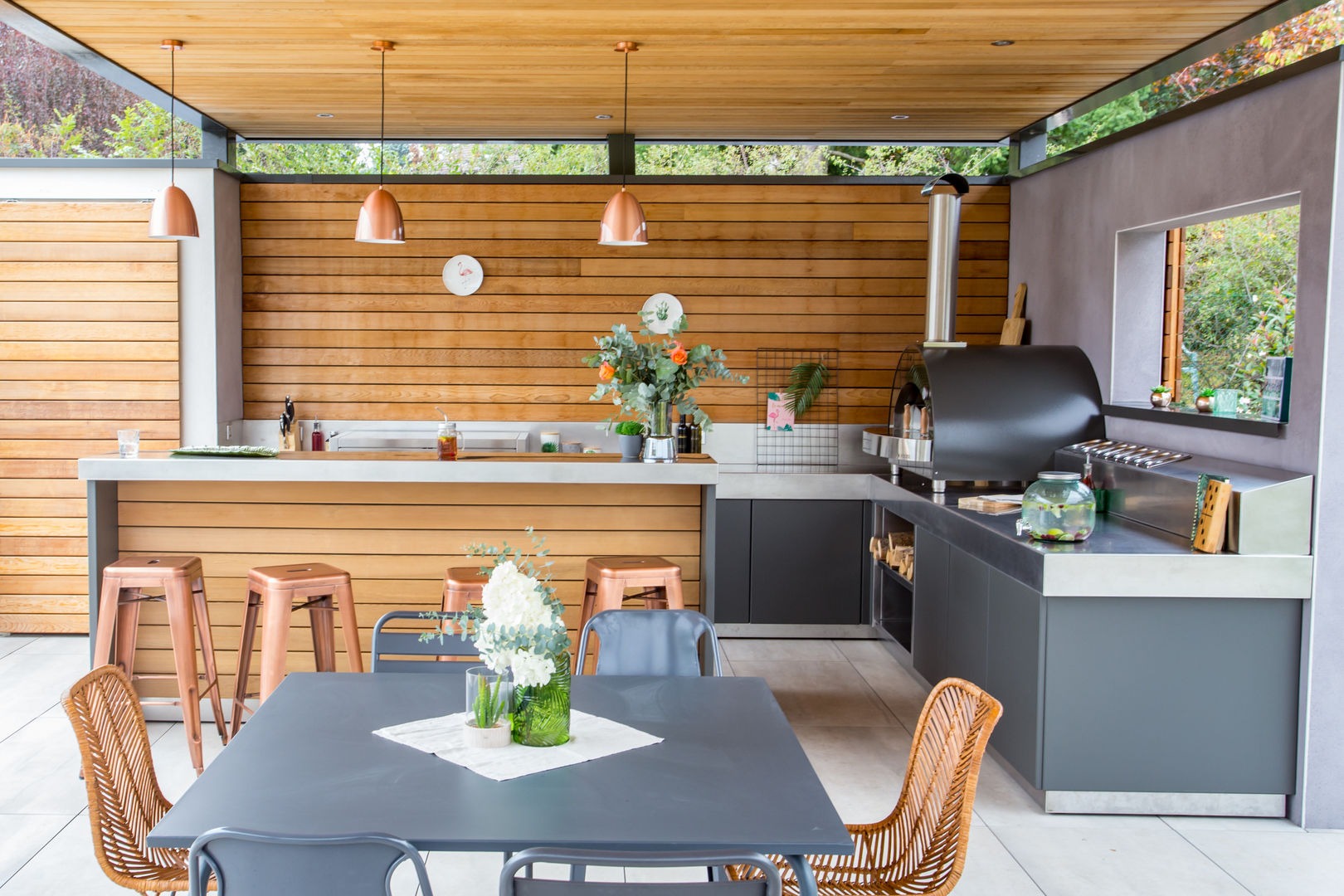
Decor and accents allow homeowners to express personality in their outdoor kitchens.
Functional layouts provide the base, but personalized touches create an environment that feels lived in and welcoming.
Ways to personalize include:
- Rugs: Outdoor-rated designs define seating or dining areas while adding comfort.
- Lighting Fixtures: Lanterns, chandeliers, or sconces introduce character.
- Art and Pottery: Weather-resistant decorations give individuality.
- Color Accents: Bold pizza ovens, vibrant chairs, or colorful cabinetry add playful energy.
Seasonal updates bring variety, keeping the kitchen fresh throughout the year.
Bright colors work well in summer, while earthy tones suit autumn gatherings.
Decorative accents should complement the larger theme while showcasing individual taste.
Personal touches make the kitchen more than a functional space.
Summary
Decorating an outdoor kitchen successfully blends comfort, function, and visual appeal.
Design themes, durable materials, cozy seating, and layered lighting create a foundation, while greenery, shelter, and decorative surfaces refine the atmosphere.
Storage solutions and personal accents keep the space both practical and personalized. Fire features finally bring warmth and an inviting glow.

